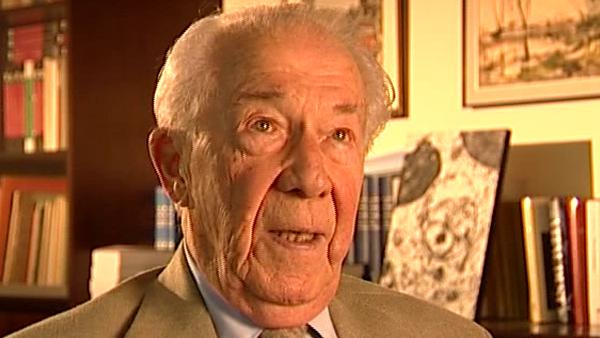NEXT STORY

Thierry Boon's work on tumour cells
RELATED STORIES

NEXT STORY

Thierry Boon's work on tumour cells
RELATED STORIES


|
Views | Duration | |
|---|---|---|---|
| 61. Learning I'd won the Nobel Prize | 241 | 03:41 | |
| 62. The 'fallout' of winning the Nobel Prize | 261 | 05:58 | |
| 63. The purpose of science | 275 | 03:28 | |
| 64. The importance of pure research | 153 | 03:15 | |
| 65. The division of the Catholic University of Louvain | 118 | 03:55 | |
| 66. Louvain-la-Neuve | 98 | 02:45 | |
| 67. The International Institute of Cellular and Molecular Pathology | 127 | 04:46 | |
| 68. Collaboration within the ICP | 84 | 03:29 | |
| 69. Expanding and funding the ICP | 67 | 03:40 | |
| 70. Thierry Boon and the Ludwig Institute for Cancer Research | 134 | 05:35 |


This was created by a man who, at that time, was the wealthiest man in the United States, Daniel Ludwig, and Daniel Ludwig had decided to use all his... well, most of his money to create a network of laboratories in which cancer would be studied. A network of laboratories because it's called the Ludwig Institute but the Ludwig Institute has no building; it has only an office in New York and it has a network of something like a dozen laboratories situated all over the world. There's one in London... well, two in London actually, there used to be one in Cambridge – was closed – there’s one... there used to be two in Switzerland – there's only one now – there's one... two now in the United States, there's one in Brazil, one or two in Australia; it's a worldwide network. And so becoming acquainted with this organisation I was able to propose the ICP [International Institute of Cellular and Molecular Pathology] as a site in which they would be able to... to create a unit, a research unit for the Ludwig Institute, and I was fortunate enough... this proposal was accepted. And so one third of this institute is occupied by the Brussels branch of the Ludwig Institute which is... occupies about 80... 80 investigators and is headed by a man called Thierry Boon who is a remarkable young man. Not so young anymore – he is the same age as my eldest son, 61 – but I'd known him from the day he was born. He was the son of one of my friends in Louvain and so I'd known him a long time so when he decided, rather to the disappointment of his father, to study medicine; the father was a very successful businessman involved with the local brewery which has become the second-largest brewery in the world. Sorry. Thierry Boon came automatically as a student, came to work as a student assistant, the way I did with Bouckaert in the old days, in my lab. And he worked mostly with Berthet, but by the time he'd finished his third year, premedical year, he had decided... the way I had decided – maybe he did it before – he didn't want to be a physician but he wanted to become an investigator, and so Berthet and I decided that, maybe, the best thing for him would be to do a PhD at the Rockefeller. And so we proposed Thierry Boon as a student – so this is another fall out of my American adventure – and he was accepted as a student at Rockefeller. Never worked in my lab; he didn't want to and I didn't want him to because there is no need to come to Rockefeller if he was going to work in an environment that was the same as he could find in Belgium. He worked with a man called Norton Zinder who was a leader in molecular biology, and so Thierry Boon did his PhD work at Rockefeller on a problem that was molecular biology. After that he went to work in Paris with François Jacob at the Pasteur Institute where he started doing some very interesting work. This time dealing not with molecular biology or phage, as he'd done in New York, or coli... he'd worked also on colisense, but he worked in Jacob's lab on tumour cells that were pluripotent. These were tumour cells that would differentiate into different kinds of cells and are responsible for tumours called teratomas. Very strange tumours; they will grow hair or teeth or all kinds of different tissues. And his idea, at that time, was to try and develop a cell line that would be programmed to become only a single one, so he wanted to study cell differentiation.
Belgian biochemist Christian de Duve (1917-2013) was best known for his work on understanding and categorising subcellular organelles. He won the Nobel Prize in Physiology or Medicine in 1974 for his joint discovery of lysosomes, the subcellular organelles that digest macromolecules and deal with ingested bacteria.
Title: Thierry Boon and the Ludwig Institute for Cancer Research
Listeners: Peter Newmark
Peter Newmark has recently retired as Editorial Director of BioMed Central Ltd, the Open Access journal publisher. He obtained a D. Phil. from Oxford University and was originally a research biochemist at St Bartholomew's Hospital Medical School in London, but left research to become Biology Editor and then Deputy Editor of the journal Nature. He then became Managing Director of Current Biology Ltd, where he started a series of Current Opinion journals, and was founding Editor of the journal Current Biology. Subsequently he was Editorial Director for Elsevier Science London, before joining BioMed Central Ltd.
Tags: Ludwig Institute for Cancer Research, Jacques Berthet, Joseph Bouckaert, Daniel Ludwig, Thierry Boon, Norton Zinder, François Jacob
Duration: 5 minutes, 35 seconds
Date story recorded: September 2005
Date story went live: 24 January 2008